Over the years, domestic lighting has evolved significantly. Today, two types of bulbs share the limelight in our homes: LED bulbs and energy-saving bulbs (compact fluorescent or CFL). If you’ve ever looked at a bulb and wondered, “Is this LED or energy-saving?” you’re not alone. This guide is designed to answer that question in a practical, visual and non-technical way.
Distinguishing between the two types of bulbs is key not only for efficiency, but also for durability, type of light and power consumption. In addition, if you are thinking about saving energy at home or renewing your lamps, knowing exactly which bulb you are using can make a big difference.
Let’s go step by step to help you identify your bulb and make the best decision.
Table of Contents
- What to look for to know if a bulb is energy saving or LED?
- Key differences between LED and energy-saving bulbs
- Which is better for you: LED or energy-saving bulb?
- Frequently asked questions about LED and energy saving bulbs.
- Conclusion: Get it right with this guide to choosing between LED and energy-saving bulbs.
What to look for to know if a bulb is energy saving or LED?
If you are going to buy a light bulb, one of the first things you should look for is the energy label. Since 2021, the European Union has changed the rating system: it now goes from A (most efficient) to G (least efficient). No more A+, A++ or A+++.
This new system is more demanding, which means that many LED bulbs that were previously at the top of the scale now appear as class C or D. It’s not that they consume more, it’s that the standards have gone up.
Today’s LED bulbs typically deliver between 90 and 160 lumens per watt, so most fall between classes C and D, although there are a few more advanced models that reach class B. Class A LED bulbs are rare and are usually reserved for very high efficiency models, which are still uncommon in the domestic market.
On the other hand, energy-saving bulbs (compact fluorescent or CFL) have a lower efficiency, between 50 and 70 lm/W, which places them in classes E, F or even G, especially if they are older models.
| Efficiency (lm/W) | New classification (2021) | Old classification |
|---|---|---|
| > 210 lm/W | A | – |
| 185 – 210 lm/W | B | – |
| 160 – 185 lm/W | C | A++ |
| 135 – 160 lm/W | D | A++ |
| 110 – 135 lm/W | E | A+ |
| 85 – 110 lm/W | F | A+ |
| < 85 lm/W | G | A or lower |
The label also shows the wattage (W) and luminous flux (lumens). That combination helps you compare bulbs. For example, if an 8W LED generates 1000 lumens, it has an efficiency of 125 lm/W, which is quite good. A 12W CFL generating 700 lumens only achieves about 58 lm/W.

Key differences between LED and energy-saving bulbs
Although at first glance they may appear similar, the technical differences between these two types of bulbs are notable. Here we break down the points that make the difference in practice.
Electricity consumption (kWh) and energy efficiency
Power consumption is probably the most pocket-relevant difference. LED bulbs consume 80% to 90% less energy than traditional incandescent bulbs, and are also more efficient than energy-saving bulbs.
To put it in perspective:
- An 8W LED bulb can give the same light as a 12-15W energy-saving bulb.
- Over the course of the year, if you have 10 bulbs on 4 hours a day, the savings can exceed €30 per year per bulb.
These savings also translate into less environmental impact. By reducing electricity consumption, less polluting gases associated with energy production are emitted.
In addition, LEDs generate almost no heat, which also improves their energy efficiency. On the other hand, low-consumption LEDs lose part of that energy in the form of heat.
Duration and estimated useful life
Another big difference is in lifespan. LED bulbs are designed to last much longer than energy-saving bulbs.
- LED bulbs: between 15,000 and 50,000 hours of use.
- Energy-saving bulbs: between 6,000 and 10,000 hours.
This means that with an LED bulb, you could go more than 10 years without having to change it, while with a CFL, you may have to replace it in less than half that time.
In addition, LEDs withstand on/off cycling better, making them ideal for areas where lights are turned on frequently (such as hallways, bathrooms or entryways).
On time and performance
A common complaint about energy-saving bulbs is the time it takes for them to turn on completely. When you turn on a CFL, you’ll often notice that it starts with a dim light and increases in intensity for a few seconds.
LED bulbs, on the other hand, turn on instantly and at full power. There is no waiting, no flickering, and no warm-up time.
This aspect may seem minor, but in rooms where you need immediate light (kitchen, bathroom, garage), the difference is very noticeable. In addition, by turning on instantly, LEDs are also safer in emergency situations.
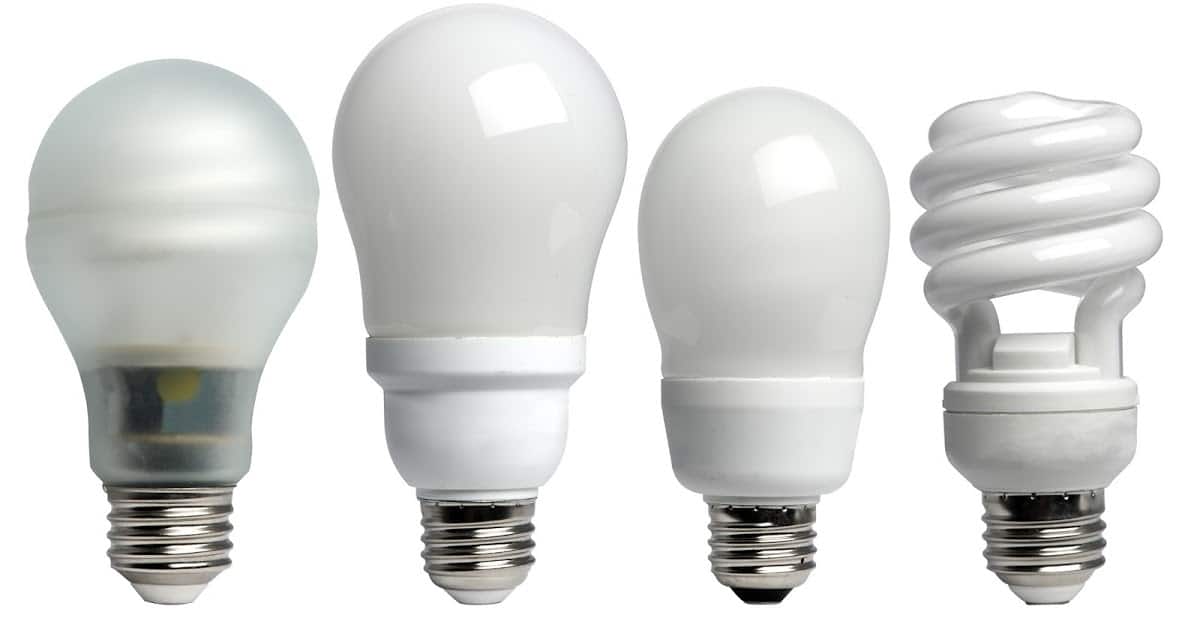
Which is better for you: LED or energy-saving bulb?
When it comes to choosing between an LED bulb and an energy-saving bulb, the correct answer is clear: go for LED technology. However, here are some use cases that can help you make the best decision.
1. For frequent domestic use: LED bulbs are undoubtedly the most convenient option. Not only do they consume less electricity, but they also last much longer, reducing the need to constantly change them.
2. If your priority is long-term savings: Nowadays you can find very economical LED bulbs that pay for themselves quickly thanks to their energy savings and long life. Within a few months of use, you will have already recovered the initial investment.
3. In areas with a lot of on/off switching: As mentioned before, LEDs are much more tolerant of repeated cycling. Therefore, for places like stairways, hallways, entrances or bathrooms, LEDs are the winning choice.
4. Aesthetics and design options: LED bulbs also win here. Today, LEDs come in all kinds of shapes, decorative styles, colors and light temperatures. Whether you want something vintage or modern in style, there’s sure to be an LED bulb to suit your taste.
5. Environment and recycling: Energy-saving bulbs contain mercury, which means that they must be recycled at specific points. LEDs, on the other hand, contain no hazardous materials, are easier to recycle and are much less polluting.
In short, for almost all cases, LED bulbs are the best choice. Only in very specific situations where a temporary and very economical solution is sought could a CFL be considered, although even in those cases, a basic LED can be just as affordable.
Recommended products
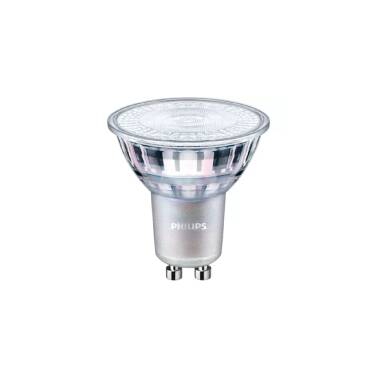
In Stock, delivery in 15-20 days
7.89 £
LED Bulb GU10 PAR16 3.7W 60º Dimmable 365lm PHILIPS Master Value LEDspot MV
View product
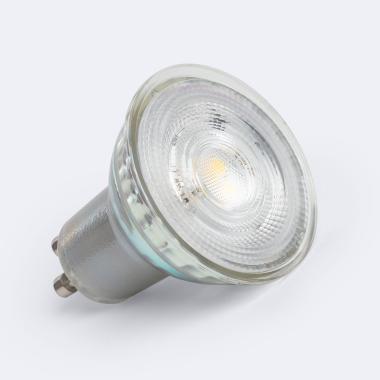
In Stock, delivery in 24/48h
2.1 £
GU10 LED Bulb 7W 30º 700 lm Glass
View product
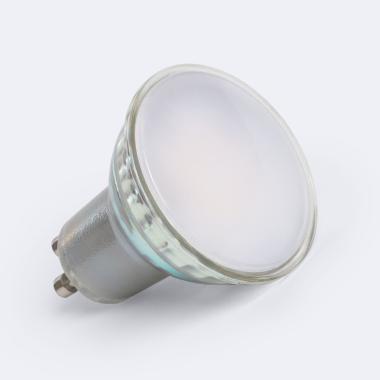
In Stock, delivery in 24/48h
2.21 £
GU10 LED Bulb 7W 100º 700 lm Glass
View product
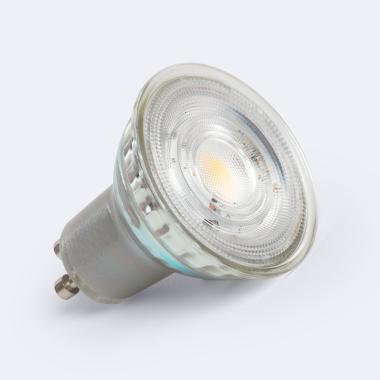
In Stock, delivery in 24/48h
3.29 £
GU10 LED Bulb 10W 60º 1000 lm Glass
View product
Frequently asked questions about LED and energy saving bulbs.
Although we’ve already covered the most important aspects, there are still common questions that many people have when faced with changing light bulbs. Let’s address them with straightforward, easy-to-understand answers.
Can an energy-saving bulb look like an LED?
Yes, and this is one of the most common mistakes. Many energy saving light bulbs (CFLs) come with an opaque white coating that makes them look very similar to an LED. In addition, some have a globe or candle shape that also mimics the style of modern LEDs.
However, there are clues that can help you:
- CFLs tend to be larger and heavier.
- They often have curved tubes inside, even if they are hidden under glass.
- They take longer to light fully.
If you are still in doubt, it is best to look at the information printed on the base of the bulb. It usually specifies whether it is “LED” or whether it is “CFL” or “compact fluorescent”.
How do I know what type of bulb I have installed?
Here is a mini step-by-step guide to identify which bulb you are using:
- Turn off the light and let the bulb cool down.
- Carefully remove the bulb.
- Look at the shape of the body: if you see spiral or U-shaped tubes, it’s probably CFL. If it is more compact and has a smooth plastic or metal surface, it may be LED.
- Look for the label printed on the bulb. It’s usually on the base. If it says “LED,” “CFL,” “fluorescent compact,” or something similar, you have your answer.
- Check the wattage and lumens: If you see an 8W bulb that gives more than 700 lumens, it’s most likely LED.
- Watch how it lights up: if it lights up instantly, it’s LED; if it takes a few seconds, it’s energy efficient.
Conclusion: Get it right with this guide to choosing between LED and energy-saving bulbs.
Distinguishing between LED and energy-saving bulbs may seem complicated, but with the right tips and tricks, it’s easier than you think. From looking at their physical design to analyzing their performance and energy label, there are multiple clues you can follow.
LED bulbs are not only the most modern option, but also the most efficient, long-lasting, environmentally friendly and versatile. Although energy-saving bulbs had their heyday, they are now being overshadowed by the many advantages of LED technology.
Remember that correctly identifying your bulb is not only useful to know what you have at home, but it will also allow you to save money, take care of the environment and improve the quality of light in your spaces. Want to know exactly how much you can save? Use our LED savings calculator and do the math.


